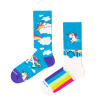What distinguishes unicorn socks?
Nowadays you can see the image of a unicorn at every step. It can be found, among other things, on notebooks, bags and various school gadgets. It is also present on our iconic unicorn socks. Interestingly, unicorn socks are chosen regardless of age or gender, highlighting the universality of the magical creatures. The fascination with unicorns has been around since the 5th to 6th centuries BC, when Ctesias, a Greek historian and physician, described this mythical creature. In ancient and medieval times, depending on the region of the world, there were various descriptions of the creature with a single horn. In the Far East it was the quilin, called the Chinese unicorn. It had the body of a deer, which was covered with green scales, and a lion's head was crowned with a crooked horn. However, over time, the image of a silver horse with a horn became most popular. In the Middle Ages, the unicorn motif became popular in Christian art. Many works depicted the image of a woman with a unicorn resting its head on her lap. It was a symbol of the Virgin Mary and Christ. It was believed that the unicorn could only be tamed by a virgin, who was identified with Mary. This motif has survived to this day, although over time it has begun to diverge from religious themes. A similar theme can be found even in the pages of Andrzej Sapkowski's The Witcher. There, too, the magical creature can only be tamed by a virgin. During the Renaissance, unicorns were less and less often associated with the religious sphere. They continued to be associated with innocence, but romantic motifs also became more common.
Magical power
For centuries, unicorns were attributed magical powers. The creatures were associated with purity, innocence, but also with immense power. Both the horns and tears of unicorns were said to have the power to neutralize poisons and heal from serious diseases. However, not everyone could get close to the animal, as they were very distrustful. Belief in the existence of unicorns was so strong that mentions of them were even found in textbooks from the Renaissance and Baroque periods. Powdered unicorn horns were supposed to serve as a cure for epilepsy and fever, among other things. Due to the popularity of these beliefs, some people decided to exploit them by creating shenanigans. Vikings recognized the similarity between the horn of a mythical creature and the twisted incisors of the Arctic narwhal cetacean. The tusks, sold as horns, fetched horrendously high prices. Many people believed that only the chosen few could get the honor of meeting a unicorn. The belief remained strong that this honor was reserved only for young women, who after meeting a unicorn are endowed with extraordinary intuition.
Unicorns in pop culture
It can be said that we are currently experiencing a renaissance in the popularity of unicorns. These magical creatures have permanently established themselves in the world of pop culture, becoming an integral part of it. Unicorns are heroes of fairy tales, animations, children's books, as well as computer games. Products signed with the image of these creatures are produced not only for the youngest, but also for adults. Among other things, stores offer alcohol and cosmetics inspired by the magic of unicorns. Many people also opt for accessories with the motif of mythical animals. You can bet, for example, on socks with unicorns, pins, bags, as well as a whole range of products that will enliven the interior of the house. Few people are surprised anymore by the sight of an adult sipping his morning coffee from a mug with a unicorn. The man thus shows distance from himself and the world around him. After all, no one has yet been harmed by a bit of unicorn magic.

